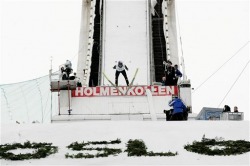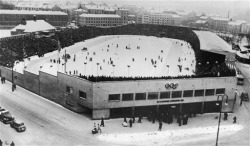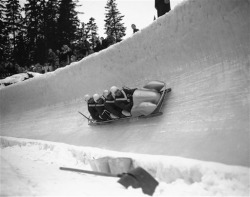Infrastructure
Oslo is the best place to host the 2022 Winter Olympics in large part because of its existing infrastructure. Many countries fall into the trap of attempting to fit the basic facilities into already bustling cities or historic districts. This then increases the chances of a failure to meet deadlines or spending money that a country cannot afford. Having already hosted such an event back in 1952, the facilities necessary for Winter Olympics have been constructed.
The four most important facilities from the 1952 Oslo Olympics are the Holmenkollen ski jump, Bislett Stadium, Frognerseteren, and Lillestrom. As is understandable with the aging and adaptation of facilities, these existing structures might require some revamping and adjustment. These tweaks will be a great alternative to construction from the ground up.
The four most important facilities from the 1952 Oslo Olympics are the Holmenkollen ski jump, Bislett Stadium, Frognerseteren, and Lillestrom. As is understandable with the aging and adaptation of facilities, these existing structures might require some revamping and adjustment. These tweaks will be a great alternative to construction from the ground up.
Holmenkollen

The Holmenkollen structure is an outdoor ski jump located in Oslo. As with many of the other facilities, Holmenkollen’s location is advantageous to travelers foreign and native alike. The basic construct has existed since 1892 and is currently in its 18th upgrade (Designbuild-network.com). Holmenkollen has had a history of being updated along with the times, and the current upgrade will ensure the ability to support modern Olympic games. Strict regulations have been taken into account for the newest changes and, “Following an inspection on 3 February the new Holmenkollen ski jump (HS134) has been certified and technically approved by Wolfgang Happle, chairman of the Sub-Committee for Jumping Hills of the International Ski Federation (FIS)” (Oslo2011.no). In addition to the Olympics in 1952 it has hosted Nordic skiing competitions regularly. “The competitors should enjoy top-class sporting conditions and a memorable public attendance in one of the world’s most modern ski arenas” (Oslo 2011 Brochure).
Bislett Stadium

The next Norwegian Olympic facility is the Bislett Stadium. This construct was a world class speed skating enclosure that hosted many events as well as records broken (Olympics.org). Since the first Olympics in Oslo, the Bislett Stadium underwent a transformation into a field sports building. The structure had not hosted speed skating for some years as the events transferred to Hamar, but it has the potential to return to its former state. This unique opportunity of two potential sites for skating provides the Olympic committee an ability to revive an original building or press on with newer facilities as they are wont to do. Bislett Stadium has the benefits of historic pride and proximity to Oslo, but Hamar has newer facilities without a substantial construction change.
Frognerseteren

The bobsled course originally used in 1952 was Frognerseteren. As with most bobsleigh courses, Frognerseteren was dismantled after its debut in the Olympics. The construction of today’s routes are of concrete and prefabricated ice with a specific amount of curves and a straight away. These characteristics can be built in the geographical spot that the original Frognerseteren was constructed or in a new site altogether. This is one of the more flexible constructs in an Olympic host’s requirements.
Lillestrøm
Lilestrom Stadium is another of the variable constructs for the Olympics. In 1952 the field was the designated hockey arena. The field was transformed into a rink for the festivities, but afterwards it was reverted to a grass field. The space remains the same as it once was, and the adaptations would require less work and monetary drain than the coordination of a whole enclosed arena. This enclosure was not covered and complimented the winter feel with real snow. In addition to Lilestrom several other hockey arenas were utilized in order to encompass the multitude of games taking place. This might seem to detract from the centralization and uniformity of the games, but it creates a unique environment for each competition. With multiple venues the transportation of spectators would encompass more of the country and provide variable benefits for all involved. Natives could attend a game at more local arenas generating a sense of national pride. This would also give incoming athletes and spectators different vantages of Norway.
Norefjell
Norway is a relatively small country, but it host to a diverse range of geographic features. With valleys and rivers the most important feature of the Norwegian landscape for the Olympics is the mountainous terrain. The beautiful range of Norefjell was the site for downhill skiing and slalom. Some countries that bid for a chance to host the Olympics are unfit due to the lack of natural geography. This absence would create an incredible monetary drain to build sufficient facilities for skiing. The slopes already in use can be viewed and adapted by the Olympic committee before the Olympics to ensure regulations are met. As the slopes are already in use, there too will be the necessary mechanical devices to achieve smooth functioning. Chair lifts and equipment to maintain slopes will already be on hand and operated by knowledgeable workers.
The beautiful country of Norway is already well on its way to host the 2022 Winter Olympics. From the slopes of Norefjell to the adaptable Lilestrom field, Oslo and its surrounding areas are equipped for world class competition. This theme is carried also to the Holmenkollen ramp that is approaching completion on its upgrades. With such an outstanding array of facilities and natural geography, Norway is the best country for the 2022 Olympics.
